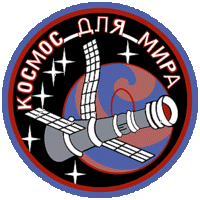 Salyut 6
the fourth Soviet orbital space station
Salyut 6 was launched from the Baikonur
Cosmodrome on September 29, 1977. With Salyut 6, the
Soviet space station program evolved from short-duration
to long-duration stays.
The station had two docking ports,
which permitted refueling and resupply by automated
Progress freighters. Progress docked automatically at the
aft port, and was then opened and unlocked by cosmonauts
on the station. Transfer of fuel to the station took
place automatically under supervision from the ground.
The second docking port allowed the long-duration
resident crews to receive visiting short-duration crews.
Salyut 6 was visited by five
long-duration crews and eleven short-term crews.
Short-duration crews often included cosmonaut-researchers
from Soviet bloc countries or countries sympathetic to
the Soviet Union. Vladimir Remek of Czechoslovakia, the
first space traveler not from the U.S. or U.S.S.R.,
visited Salyut 6 in 1978. The station also hosted
cosmonauts from Hungary, Poland, Romania, Cuba, Mongolia,
Vietnam, and East Germany.
An experimental transport logistics
spacecraft called Cosmos 1267 docked with Salyut 6 in
1982. Originally designed for the Almaz program, Cosmos
1267 proved that large modules could dock automatically
with space stations, a major step toward the multimodular
Mir station and the International Space Station.
The station was deorbited on July 29,
1982.
Specifications
| Length: |
15.8 meters |
| Maximum Diameter: |
4.15 meters |
| Habitate Volume: |
90 cubic meters |
| Weight at Launch: |
19,824 kilograms |
| Number of Solar Arrays: |
3 |
| Span of Solar Arrays: |
17 meters |
| Area of Solar Arrays: |
51 square meters |
| Number of Docking Ports: |
2 |
| Total Occupation Period: |
683 days |
Missions and
Crews
visiting missions are in italics
| Mission Name |
Mission Dates |
Crew |
Notes |
| EO-1 |
December 10, 1977 - March 16,
1978 |
Yuri Romanenko, Georgi Grechko |
broke a record set on board Skylab, staying aboard for
96 days |
| EP-1 |
January 10, 1978 - January
16, 1978 |
Oleg Makarov, Vladimir
Dzhanibekov |
|
| EP-2 |
March 2, 1978 - March 10,
1978 |
Aleksei Gubarev, Valdimir
Remek |
Intercosmos flight |
| EO-2 |
June 15, 1978 - November 2, 1978 |
Vladimir Kovalyonok, Aleksandr
Ivanchenkov |
140 days |
| EP-3 |
June 27, 1978 - July 5, 1978 |
Pyotr Klimuk, Miroslaw
Hermaszewski |
Intercosmos flight |
| EP-4 |
August 26, 1978 - November
2, 1978 |
Valery Bykovsky, Sigmund
Jähn |
Intercosmos flight |
| EO-3 |
February 25, 1979 - August 19, 1979 |
Vladimir
Lyakhov, Valery Ryumin |
set a new space endurance record of 175 days |
| |
April 10, 1979 - April 12,
1979 |
Nikolay Rukavishnikov,
Georgi Ivanov |
Intercosmos flight; failed
docking |
| |
June 6, 1979 - August 19,
1979 |
|
launched empty to replace
Soyuz 33; landed with long-duration crew |
| EO-4 |
April 9, 1980 - October 11, 1980 |
Leonid Popov, Valery Ryumin |
185 days |
| EP-5 |
May 26, 1980 - July 31, 1980 |
Valery Kubasov, Bertalan
Farkas |
Intercosmos flight |
| EP-6 |
June 5, 1980 - June 9, 1980 |
Yuri Malyshev, Vladimir
Aksyonov |
|
| EP-7 |
July 23, 1980 - October 11,
1980 |
Viktor Gorbatko, Pham Tuan |
Intercosmos flight |
| EP-8 |
September 18, 1980 -
September 26, 1980 |
Yuri Romanenko, Arnaldo
Tamayo Mendez |
Intercosmos flight |
| EO-5 |
November 27, 1980 - December 10,
1980 |
Leonid Kizim, Oleg Makarov,
Gennady Strekalov |
a repair mission lasting 12 days |
| EO-6 |
March 12, 1981 - May 26, 1981 |
Vladimir Kovalyonok, Viktor
Savinykh |
75 days |
| EP-9 |
March 22, 1981 - March 30,
1981 |
Vladimir Dzhanibekov,
Zhugderdemidiyn Gurragcha |
Intercosmos flight |
| EP-10 |
May 14, 1981 - May 22, 1981 |
Leonid Popov, Dumitru
Prunariu |
Intercosmos flight |
WEB SOURCE
NSSDC Master Catalog Display: Spacecraft
nssdc.gsfc.nasa.gov
Questions or comments about this
page?
|
 SKC Films Library
SKC Films Library